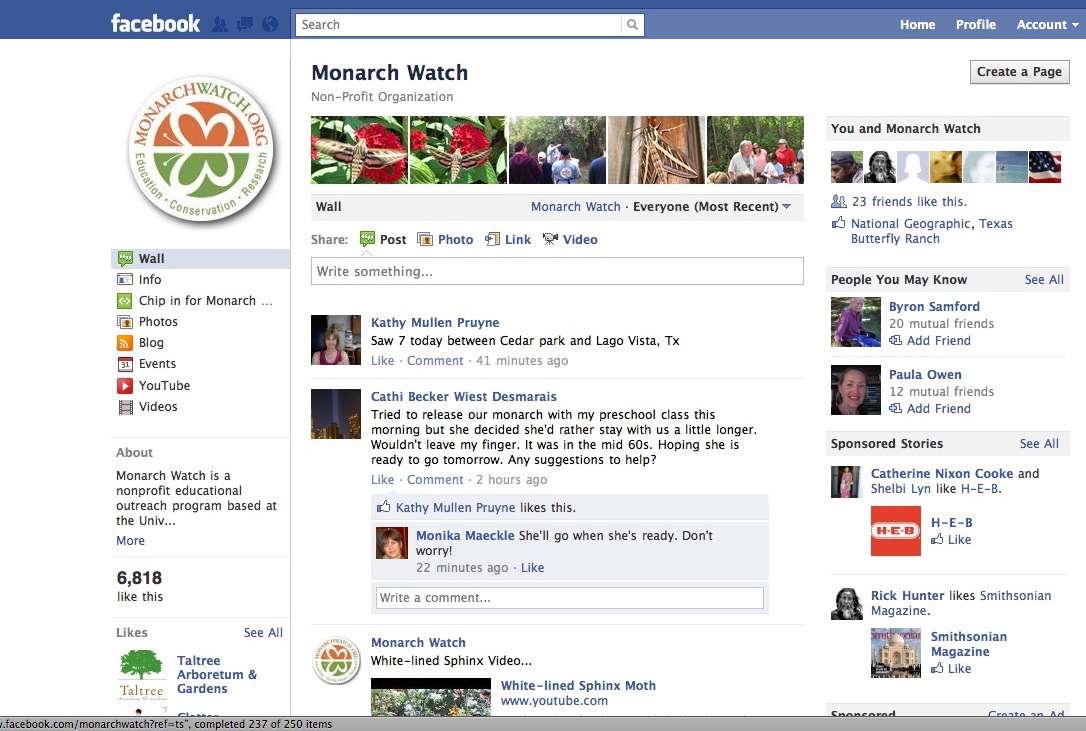The Monarch Butterfly Migration is underway, and social media and online resources make it easier than ever to track the butterflies’ progress as they leave the nectar in the North for their ancestral roosts in the mountains of Michoacan, Mexico.
Here are my favorite online resources for tracking the Monarch migration.
Journey North
Billed as the nation’s premiere citizen scientist project for children, Journey North tracks wildlife migrations and seasonal change. This time of year, they post a weekly migration update on Thursdays based on observations from Monarch butterfly enthusiasts of all ages, from Canada to Mexico. Here’s an excerpt from a recent report:
Roosts: Fewer, Smaller, and Short-lived
So far this fall, only 43 roosts have been reported compared to 156 reports last year at this time. (See chart.) This year’s roosts have also been small. Most have had only a few hundred butterflies and the largest contained about 1,500. Last year at this time, the largest roost had 10,000 monarchs (See photo.) This fall’s roosts have also been short-lived.
Written for kids and educators, Journey North offers loads of tools and resources for teachers and others on the Monarch butterfly migration. The site also invites participants to report their sightings and collates the information for online viewing. The database provides an interesting thumbnail sketch of the migration in real time.
Monarch Watch
While Journey North devotes itself to wildlife migrations besides Monarch butterflies (they also monitor hummingbirds, whales and birds), Monarch Watch brags Monarch butterflies, all the time.
Based at the University of Kansas, Monarch Watch founded the citizen scientist tagging program embraced by thousands of us who tag Monarchs each fall. Its comprehensive website at www.monarchwatch.org offers information on how to tag a Monarch, raising milkweed, rearing Monarch caterpillars, and a database of all the Monarch tags recovered in Mexico, so those of us who tag can search and find if any of our butterflies made it home. The site also posts predictions for when the peak migration will occur at your latitude, all based on Monarch Watch scientists’ well-researched opinions.
Equally interesting is the Monarch Watch blog, where Monarch Watch founder Dr. Chip Taylor waxes scientific about the State of the Union of Monarch butterflies. Dr. Taylor’s annual population status reports are must-reads for entomologists and those of us who care about Monarch butterflies.
Monarch Watch Facebook page
But the most fun and timely way to track the Monarch butterfly migration is to keep an eye on Monarch Watch’s Facebook page. With its 6800+ fans, the page offers a delightful daily stream of photos, insights, observations, questions and links from across the country.

Monarch Watch Facebook page: never a dull moment
Be sure to click on the “everyone” tab so you can read firsthand what Monarch maniacs from all over the country are seeing in their gardens and wildscapes. Butterfly wranglers post chrysalis pictures, caterpillar snapshots and digital documentation of how they’re lending a hand to a unique natural phenomenon that scientists believe is under severe threat. Here’s a sampling:
Mike Reim Spotted some Monarchs (dozen or so) resting in our cedar trees on our acreage in Purcell, OK and some in Norman, OK on the OU Campus.
Laurie Walz Here at Latitude 40, we had a major group of butterflies eclose two weeks ago, but seen no eggs since. I’m down to 1 fifth instar and 8 chrysalises. Are we through for the season, or will things pick up again?
Ann Rogerson Weaver Big weather change here….93 degrees on Friday and 60 degrees on Sat. I released 26 Monarchs yesterday morning and this morning there are still 21 of them hanging around on my front porch. Guess they don’t like the cooler temps. They have zinnias and sedum flowers for nectar, but don’t appear to be eating. Still have 79 caterpillars feeding and think they will be my last….eastern NC
Social media serves the Monarch butterfly migration well. All we need now is a Monarch butterfly Twitter feed to post real-time check-ins from the clouds. Any volunteers?


How do I find out if anyone saw any of the Monarchs that my 7th grade science class tagged last year? I never new how to follow them and I feel it was a big disappointment to my class not to hear about any of them.
Hi Susan,
Great question. I also tagged Monarchs for years, not knowing that you could check the Monarch Watch database to see if any of them had been retrieved down in Michoacan or somewhere in between. Just goto http://www.monarchwatch.org/tagmig/recoveries.htm and click on the link to search the Monarch Watch recovery database. You can search by name or tag number–even location. It will serve up any matches of Monarchs that were recovered by the native guides there or anyone who intercepted or found a Monarch tagged in between, and called it in.
Native guides in Michoacan find dead butterflies on the forest floor and save the tags, reporting them to Monarch Watch. They generally receive $5 per tag, so they have an incentive to look for, find and keep them. Check the database and let me know what happens. Good luck and thanks for writing.
[…] wrote a few weeks ago about using online and social media tools to keep up with Monarch butterfly news. Even more immediate data can be gleaned from Twitter […]
[…] wrote a few weeks ago about using online and social media tools to keep up with Monarch butterfly news. Even more immediate data can be gleaned from Twitter search.For those unaware, Twitter is a free, […]